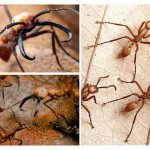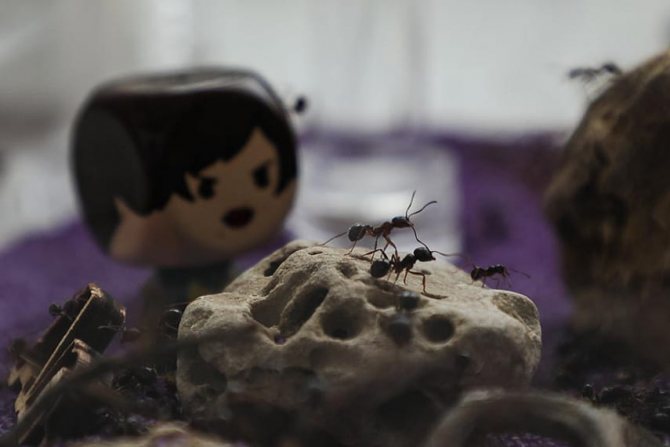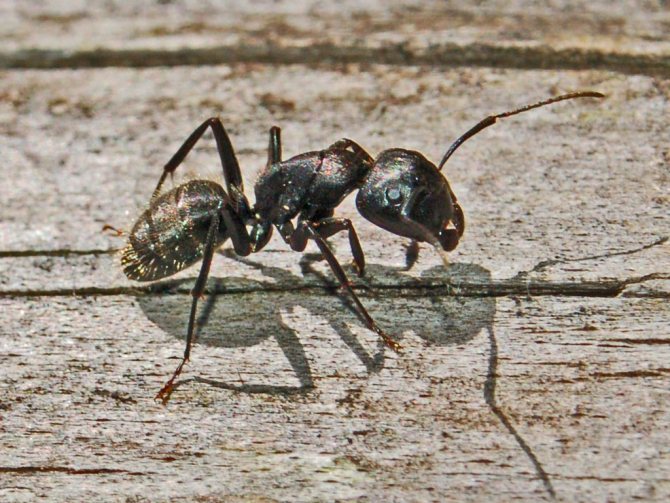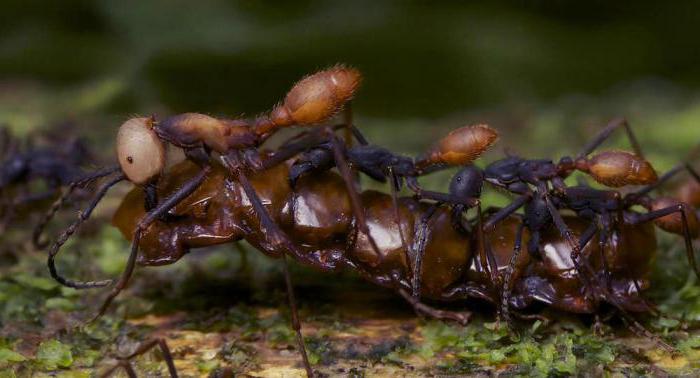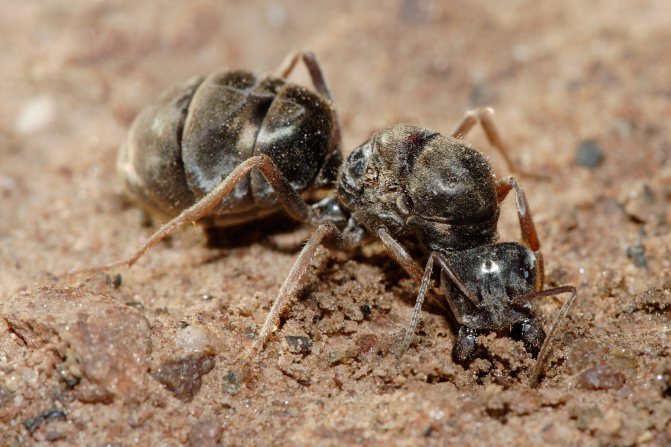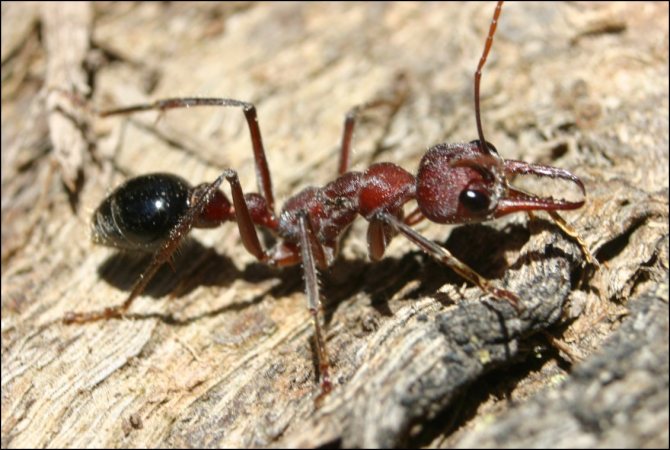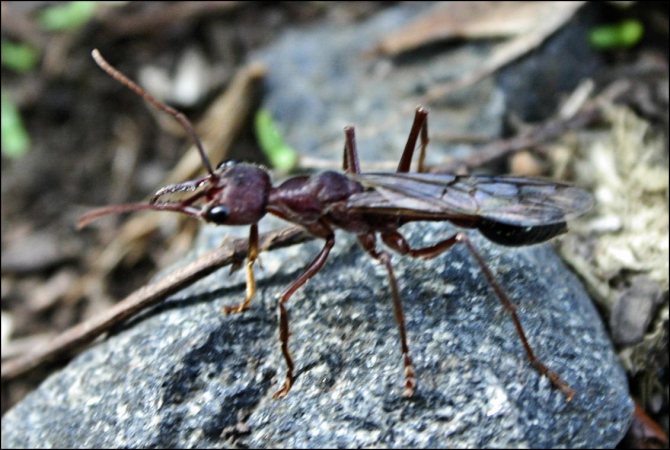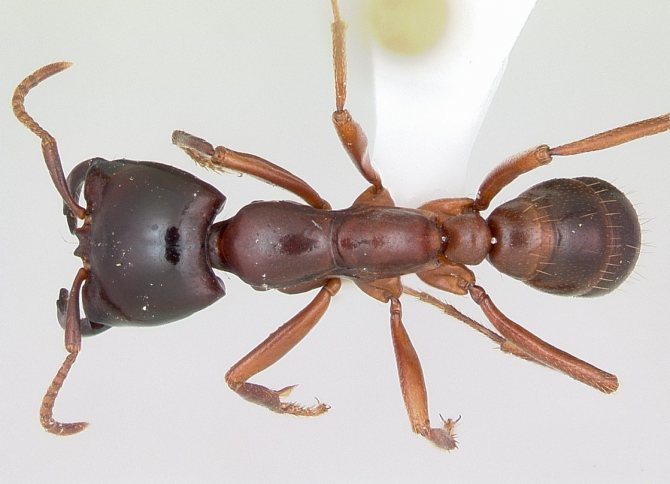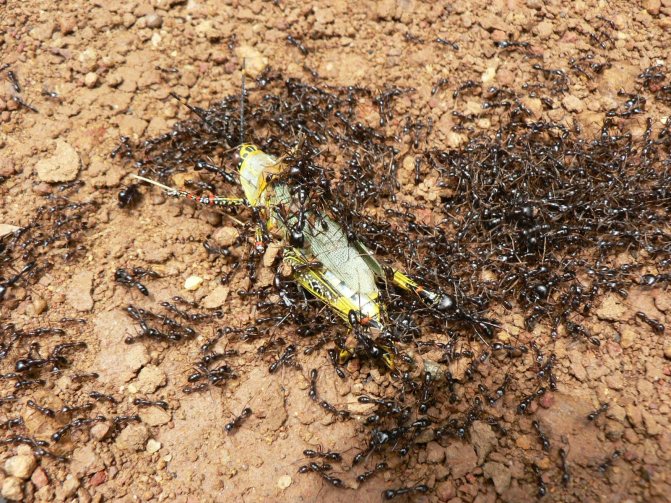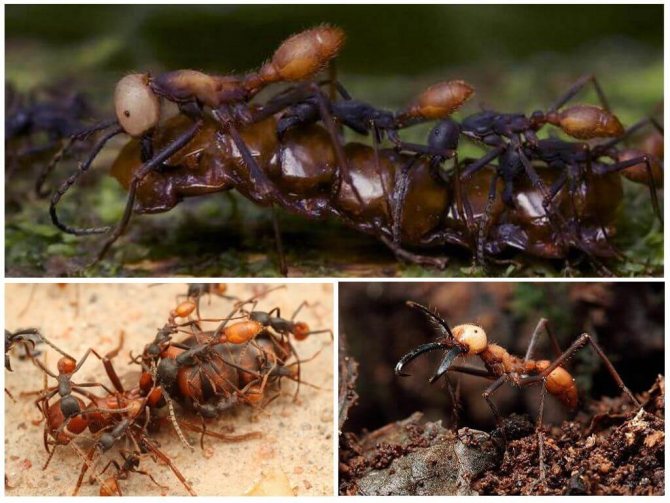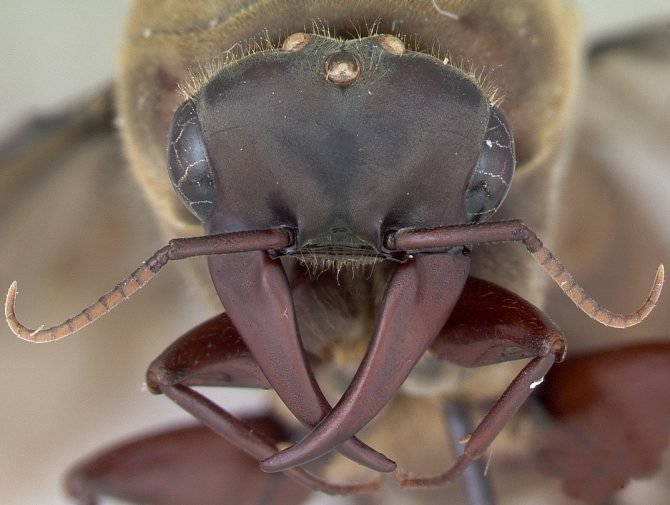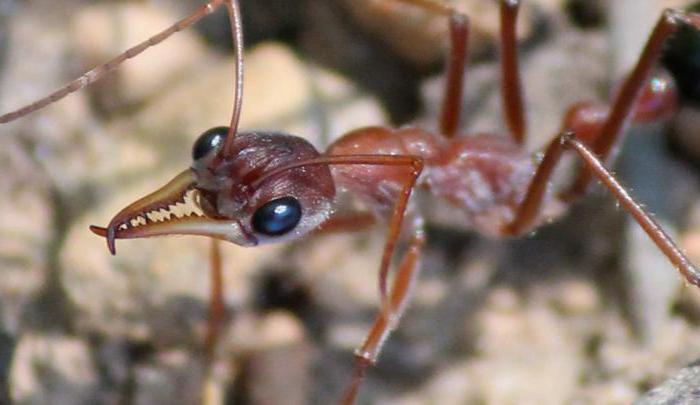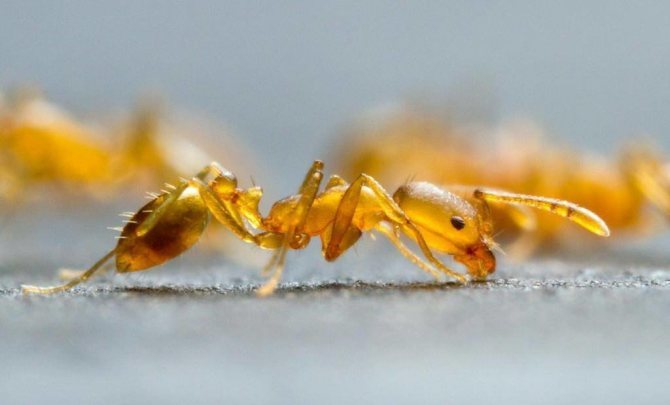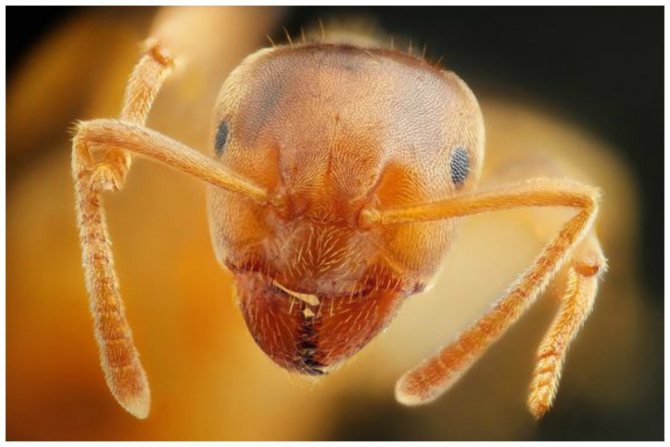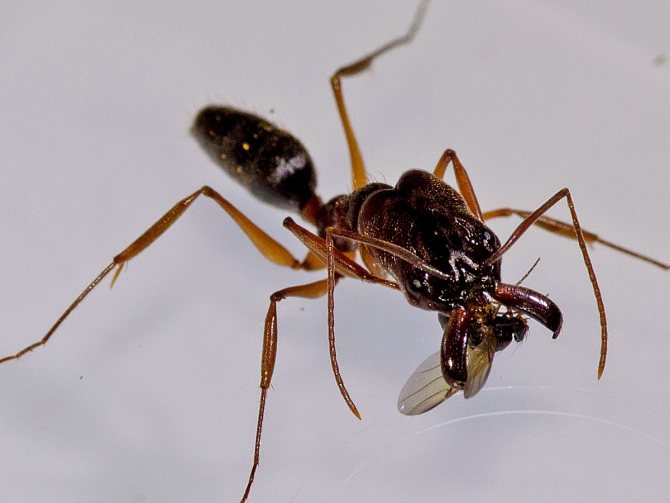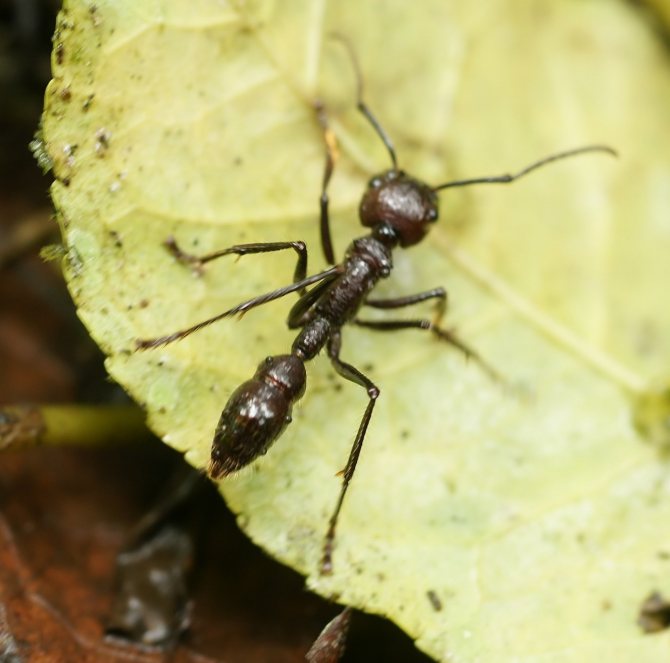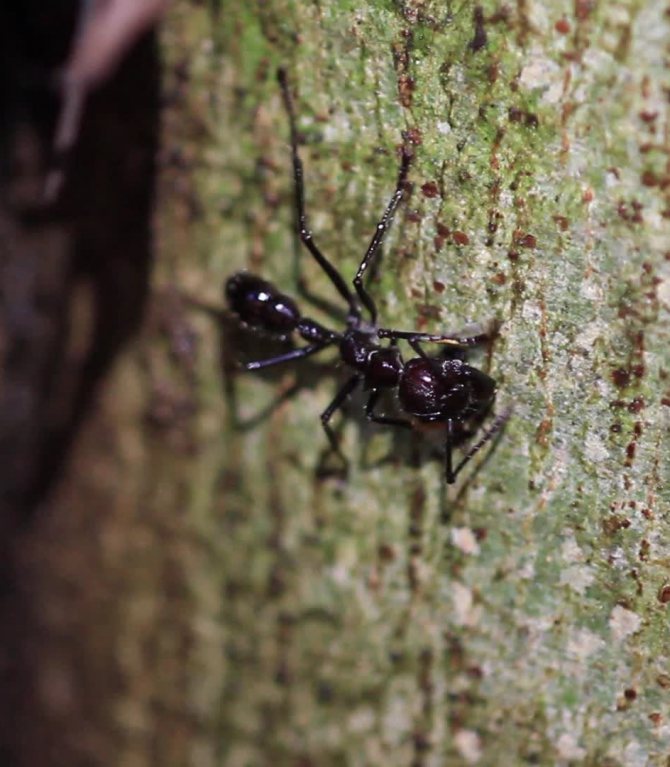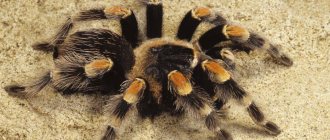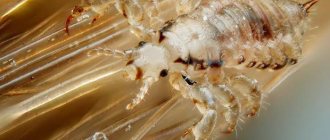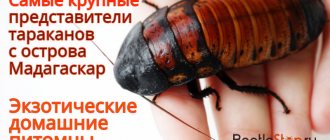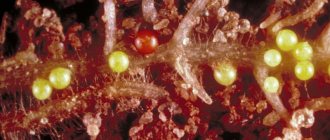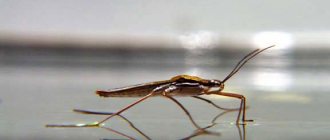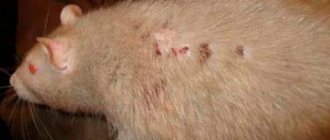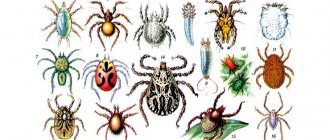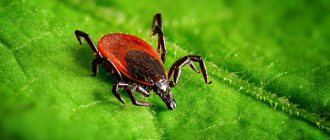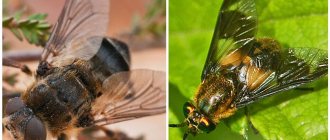In our latitudes, the concept of an ant is associated with a small insect that spends its entire life in hard work. In most cases, they are harmless. The only danger they pose is crop damage or slight redness at the bite site, which quickly passes. But there are also very dangerous representatives of this species in the world. Killer ants are capable of attacking people and sting mercilessly, letting dangerous poisons under their skin.
Nomadic ants
This species got its name for a reason, the fact is that they do not settle in one place, they do not build anthills, but prefer to constantly travel. They gather in large colonies and move from one territory to another.
They also have the name siafu, and because of their way of life they are called wandering. But this name will not be complete, since it always ends with the word murderer.
The dimensions of the string are simply impressive. They are assembled in a column, the width of which can be more than 10 meters. Towards the end it narrows, the length of such a procession can reach 45 meters. In one hour, they cover a distance of about 300 meters, they travel mainly during the day. They belong to the inhabitants of Asia, South and North America, Africa.
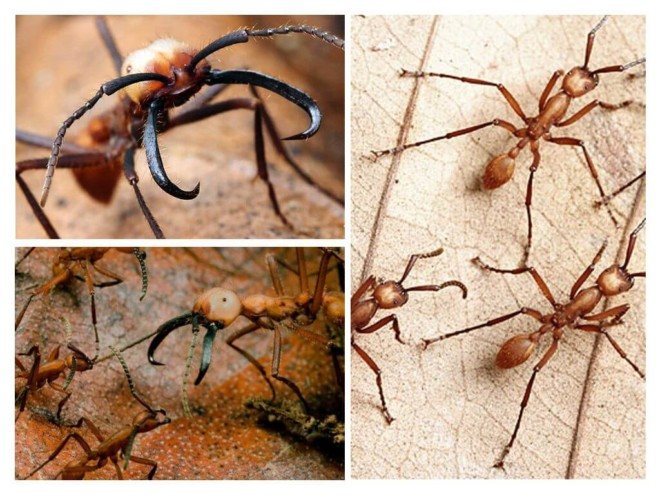
When such a huge colony moves, absolutely everyone who meets them on the way disappears. Of course, they need food, therefore, beetles, woodlice, caterpillars on the route that they passed, become their food. But, they are not limited to insects, nomadic killer creeps attack small animals.
They can attack mice, lizards, snakes, frogs. They do not attack people as they do victims, but they can attack in self-defense when they feel a threat to themselves or their colony. When attacked, they inflict very painful bites that can cause allergic reactions that are difficult for the body.
The size of these insects is really impressive, they are one of the largest ants in the world. There are ants of different sizes in one colony, they belong to different castes and perform different functions. When a column is walking, ants are soldiers always walking along its edges, they perform the function of guarding their relatives.
Their size reaches 15 mm, but in addition to the large size of the body, they boast huge and strong jaws, which are much larger than the size of the head.


There is a female that produces offspring, she no longer performs any functions. The female is the largest individual in the colony; during the laying of eggs, the size of her body reaches 50 mm. In the middle of the column, workers goosebumps, they carry food supplies and future offspring on themselves.
When evening falls, they stop and build a temporary nest for the night. This happens in the following way, all working individuals cling to each other with their paws and build something like a nest so that the uterus is protected.
It is worth mentioning the peculiarities of reproduction, which no other insect in the world possesses. Reproduction itself has no peculiarities, but the number of eggs that a female can lay in one day is simply amazing. They are very fertile and one female can lay up to 130 thousand eggs in one day.
Do nomadic ants have enemies?
Oddly enough, but such a dangerous insect as a nomadic ant still has an enemy - this is a praying mantis.But the organization of the ant colony is so high that insects can easily cope with even such an enemy. Seeing a praying mantis, one of the ants rushes to it and bites with its jaws, injecting poison. Even if the insect dies, the rest of the individuals, seeing such a signal, group up and repulse the offender. In this case, you will not envy the praying mantis, he is in danger of death.
Because of such a collective organization of the column, no one runs the risk of hunting ants.
Fire ants
This species can easily be attributed to the inhabitants of the whole world. Although South America is considered their native habitat, they quickly spread to new territories and, due to the fact that they easily adapt to new conditions, have taken root in our country. They are very fond of settling in people's living quarters and they are not afraid even of perfect cleanliness in apartments and houses. Getting rid of the colony is difficult enough.
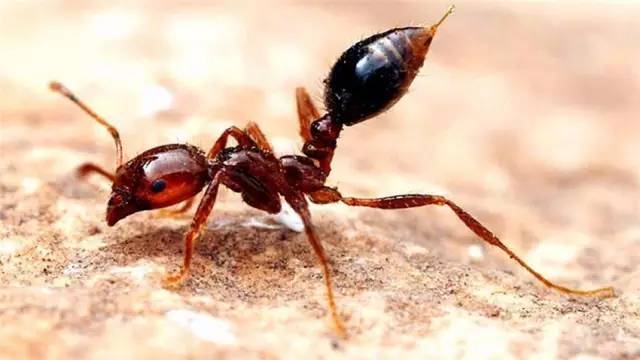

They are very tenacious and hardy, this is what allowed them to spread throughout the entire world, and the infection took place through sea routes. Their life cycle consists of several stages of development. First, the uterus lays eggs, then they are reborn into larvae, then into a pupa and the final stage are adults.
At all stages of development, individuals are not capable of functioning until they develop into adult goosebumps. They do not leave the nest and cannot soak themselves in any way, so they are served by working insects. Regarding the size of these goosebumps, they cannot be attributed to the largest individuals. An adult ant grows up to 6 mm.
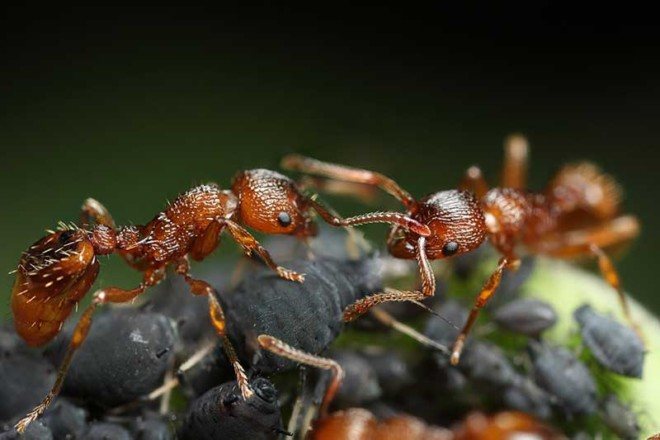

The color of their bodies allows you to immediately determine which species they belong to. They can be saturated scarlet or brown. If you notice such "guests" in your home, you need to start dealing with them as soon as possible. The longer they stay next to you, the more difficult it will be to get rid of them. Most often, strong insecticides are used in the fight against them.
Reproduction
The breeding process takes place during stops, which a moving column of nomadic
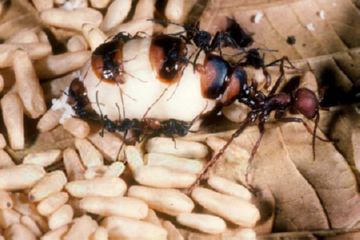

ants commits every 7-10 days. At a halt, some worker ants form a temporary nest from their bodies, while others feed the queen female inside this nest. The abdomen of the uterus increases several times, and she begins to lay eggs - about 25,000 per week.
The worker ants carry away the eggs and switch to feeding the larvae that hatch from them. At the same time, the female receives less food, and her abdomen begins to deflate. When this breeding cycle is completed, the colony again begins to prepare for the campaign. More and more adult ants emerge from the cocoons, the uterus is again ready to move - and at the appointed time, the stray ants line up in a column and move forward.
Yellow ants
The appearance of these individuals is quite deceiving, since they seem to be completely harmless. These small individuals are the most poisonous insects in the world. They do not live in our country, poisonous insects live only in the state of Arizona. If we talk about the danger posed by yellow ants, then meeting with them can be fatal.
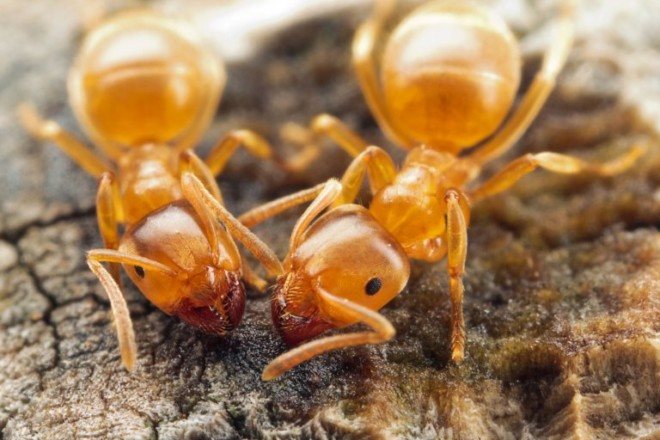

When this insect attacks, severe swelling appears at the site of the bite. When bitten, they secrete poison, which causes a severe allergic reaction. One insect kills an animal weighing 2 kg with poison. There are cases when the bite of one goosebump led to the death of a person.
Food
Stray ants are predators, moving in search of food take up most of the time of these insects. Invertebrates form the basis of food, mainly others
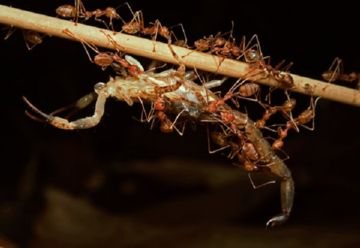

social insects such as termites, wasps, bees. Their nests, met by a column on the way, are destroyed by nomadic ants. The nomads eat their victims to death or kill with poison.
Small vertebrates make up a small proportion of the diet of stray ants.These can be frogs and reptiles, as well as birds nesting on the ground. Nomad ants destroy all small animals that come across on the path of the column. True, these predators move rather slowly, so only those animals that cannot escape can become their victims.
They are eaten by nomadic ants and carrion. Their food can be either a dead frog or bird, or the carcass of an elephant.
Ants bulldogs
This species is distinguished by the large size of individuals, in addition, they are classified as the most dangerous and aggressive insects. Workers of the colony reach 40 mm in length, the uterus is the largest representative of the colony, its size reaches 45 mm.
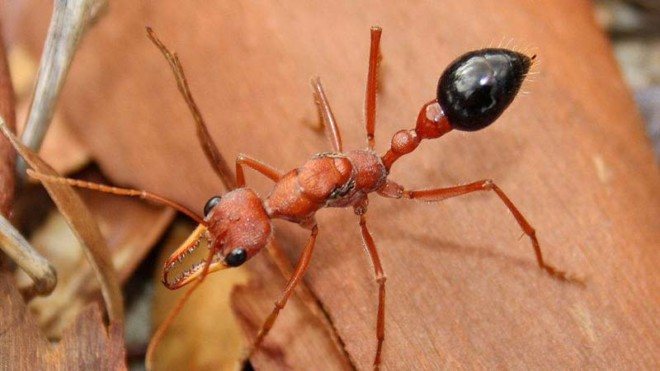

In addition to the huge size of the body, they have very large and strong jaws. Their jaws grow in the form of 2 canines, which are serrated on the inside. When attacking, they easily capture the victim and there is absolutely no chance of snatching it out of such a trap.
But jaws are not the only privileges, they have a sting like a wasp. Unlike a wasp, they can use it many times. When pierced with a sting, they secrete poison, which can be fatal.
One individual will not kill a person, there will be inflammation of the skin, severe itching, swelling of the limbs and larynx may be observed. But if we take into account the fact that they live only in colonies, and the guards who guard the nests and attack from 3 to 5 individuals attack people, then the likelihood of a tragedy increases significantly.
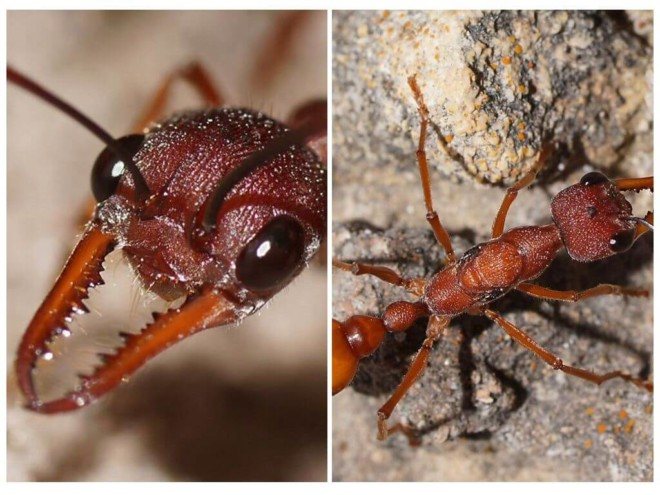

Local residents are very well aware of such dangerous insects and always bypass territories where there are anthills. If you turn to the statistics, you can see how dangerous they are, because more people die from these goose bumps than from poisonous spiders and snakes.
Fascinating facts about nomadic ants
- The nomadic killer ants, which pose a mortal danger to humanity, are a complete fiction created by the film industry. Of course, insect bites are a big threat to people who are allergic to toxic substances, but not a single case of human death was recorded. Therefore, it would be unfair to call nomad ants killers.
- These insects are excellent orderlies. They clean agricultural plantations from various pests.
- On the African continent, nomadic ants are the most dangerous predators.
- Insects are able to follow in the footsteps of their relatives.
- Ants have no vision at all, but their hearing is well developed.
- The queen in the colony has no rights. Her task is to breed new offspring.
- The peoples of Central Africa leave their homes and move their livestock away as soon as information appears that a column of ants is moving in the direction of their settlement.
- If nomadic ants move in the direction of the prison, then prisoners who have not committed serious crimes and are not sentenced to death are released during the invasion of insects.
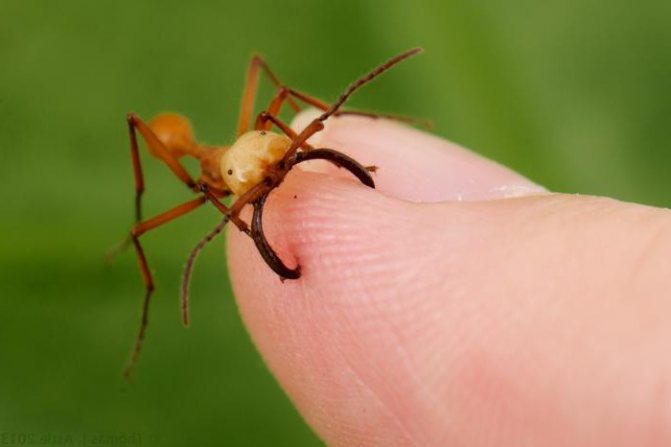

Red ants
No less dangerous representatives with whom it is better for a person not to meet. It is not difficult to distinguish them from other species, since they have a bright red calf color. The danger to humans is that when bitten, they release a strong poisonous substance - synopsin.
This substance, in addition to a severe allergic reaction, causes severe chemical burns and pain. It can be compared to a burn from an open flame. The consequences may be different, at best, the attack will end with an allergic reaction, but anaphylactic shock may develop.
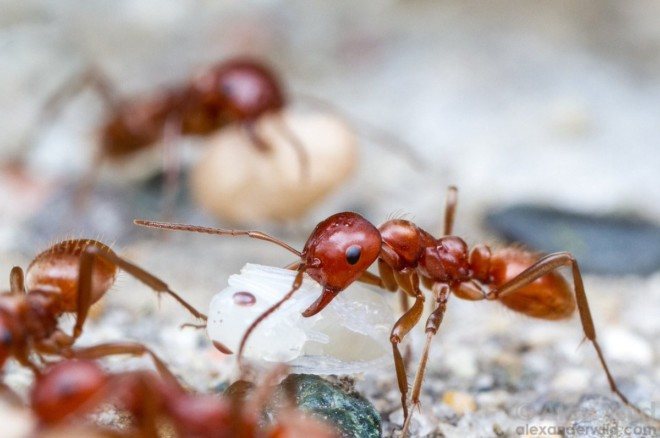

Most often, an attack occurs by a group of ants, they do not attack alone. It is also worth saying that they do not attack people just like that, but only if they feel a threat to themselves or their colony. Several thousand people suffer from their bites every year. The symptomatology is as follows, at first the place drains strongly, a blister appears, in the place of which scars remain.
A person develops dizziness, nausea and vomiting, allergic reactions. Until recently, they lived only in America, but now they can be found in other countries, and Russia is no exception.
Why are the most dangerous ants in Africa
It is believed that poisonous and dangerous ants can be found in Africa. It is there that the number of insects is greatest. Some of the representatives do not even have anthills and are forced to constantly move in search of food and favorable conditions.
The large number of dangerous ants is due to the fact that people do not begin to fight against pests, but leave their homes when insects appear. For this reason, uncontrolled reproduction occurs. The number of assassins is growing rapidly.
On the territory of Russia and neighboring countries, it is impossible to meet poisonous parasites in the wild. This is due to the fact that the insect chooses a tropical climate for living. This is necessary for normal development and reproduction.
Ants bullet
A species of ants, meeting with which can end in very serious consequences. They got their name “bullet” for a reason. The fact is that their bite is painful compared to a gunshot wound.
This is a very painful bite, unbearable pain appears from the toxic substance poneratoxin, which is released during the attack. This type is also called "24 hours", and all for the reason that after a bite a person suffers from severe pain and cramps throughout the day.
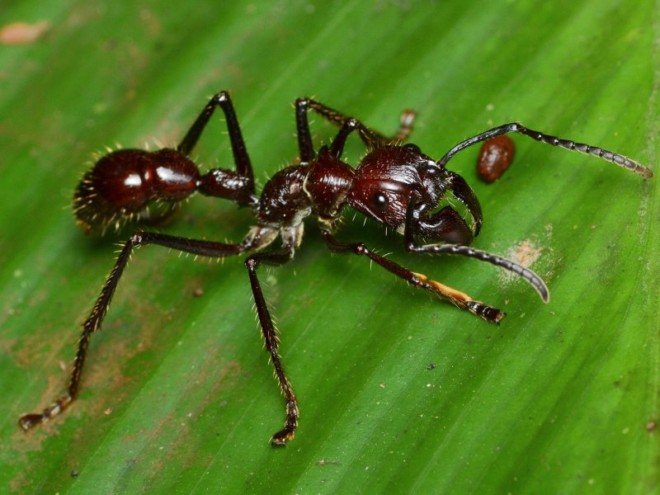

Regarding external characteristics, they cannot be called the largest individuals, working ants reach 25 mm in size, the uterus, of course, is larger than other individuals of the colony, they grow up to 30 mm. These are the inhabitants of South America, unlike other types of goosebumps, they feel great on trees.
They will climb the crowns and branches of trees for hunting. When they see a victim, they jump on it, and when they fall, they make a peculiar sound resembling a squeak. They do this in order to notify other goosebumps of their colony about the attack on the victim. Therefore, not one individual or even a dozen attacks, but a whole colony.
Army Soldier Ants (Eciton burchellii)
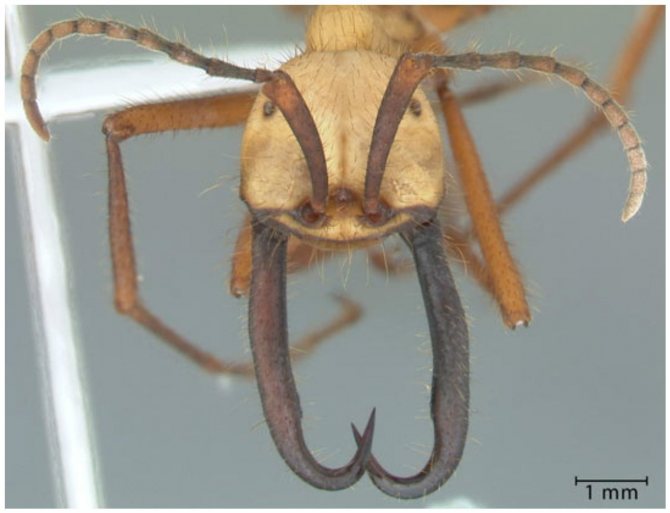

0
A source:
Huge ants - up to 1.5 centimeters are found in the channels of the Amazon. They are afraid of them due to the fact that on their way they disassemble everything that comes across. They do not have permanent anthills, often move in huge flocks (up to 20 million individuals), blind but devour whatever they come across.
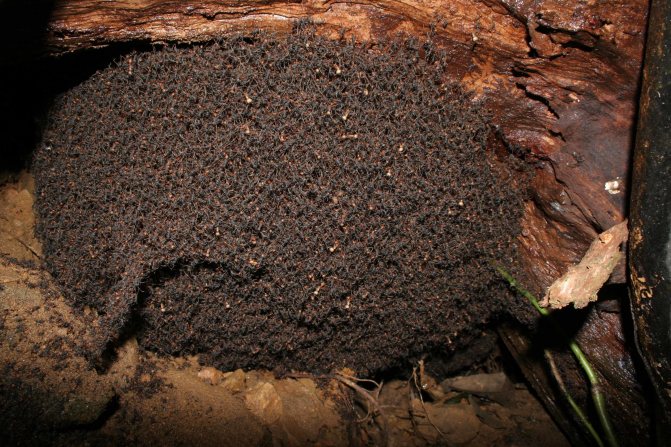

0
Attacks on humans
Due to the fact that these insects are inhabitants of warm tropical countries, the threat of attack is present all year round. Most often, locals and tourists from Africa, America, Australia are attacked. A huge number of attacks are known, which were grave and fatal.
For example, there is a known case that happened in America. An attack of poisonous ants occurred in a nursing home, it happened in 1999. The attack occurred when the elderly were resting in bed and could not provoke the attack in any way.
Insects inflicted multiple bites on two elderly men. Despite the fact that the necessary medical actions were immediately taken and the treatment was used, the first man died after 5 days, and the second after 14 days.
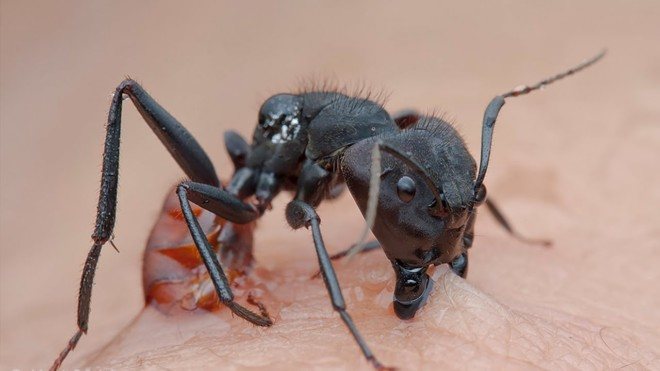

Although they are inhabitants of natural conditions, attacks in residential premises are regularly recorded. The consequences of attacks are different and not always fatal. There is a known case when these insects attacked a nursing infant, he fell into a coma, but fortunately survived. There was also an attack on a 2-year-old boy, an ant bit into the cornea of the eye, in addition to emergency medical care, an urgent operation was also required.
Two elderly people could not survive the attack, which took place at their home, a week later, both were killed.But there are cases when serious consequences were avoided after first aid.
Each organism individually reacts to the poison that enters the body. The same poison and in the same quantity in one person can lead to death, and in the second it does not even cause complications. But you can't hope that everything will work out, you need to take all possible measures that will help protect yourself and prevent difficult situations.
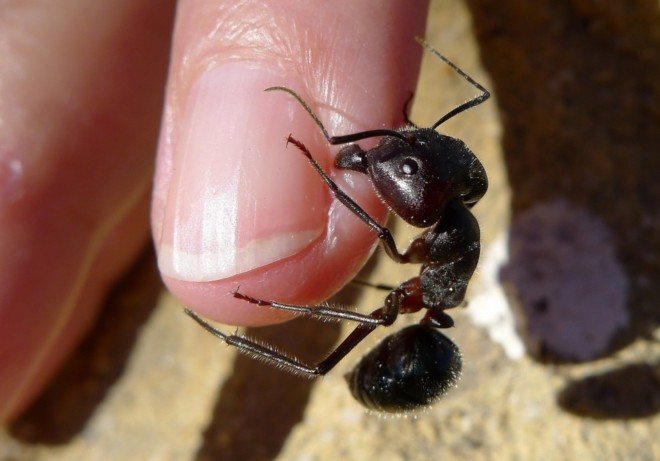

If you go to exotic countries, then go on excursions only with guides who are well aware of the possible dangers. In addition, it is recommended to use specialized protection products in the form of sprays and gels. Be sure to take antihistamines with you, which in case of a bite should be taken before receiving first aid.
Consequences of attacks
The venom that ants secrete when bitten is a potent toxic substance. It affects the human nervous system, which can lead to paralysis and death. One insect releases a small dose of poison, which is most often not fatal, but causes many complications.
Redness and swelling appear at the site of the bite, then the skin begins to become inflamed, severe itching, burning, pain appears, and swelling develops. The vascular system suffers, in a person who is prone to allergic reactions, symptoms are manifested by dizziness, weakness in the body, headache, body temperature rises, nausea and vomiting appear, and there are disturbances in the coordination of movements.
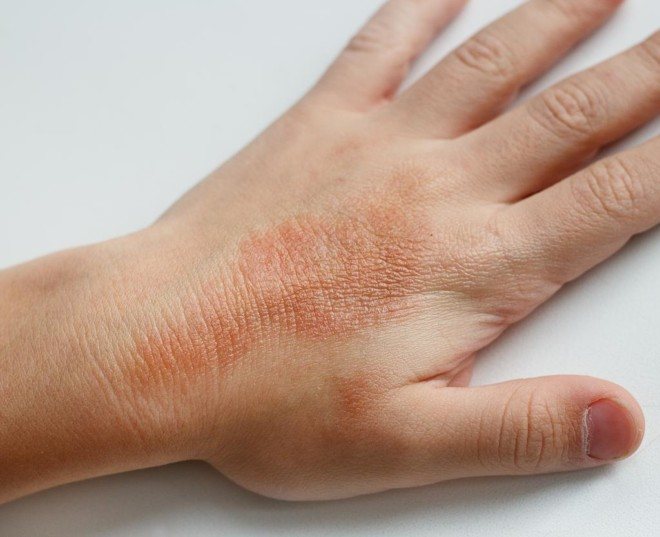

This condition in a person can be observed for several days. To get rid of the symptoms, you need to take antihistamines, as well as antiallergic drugs.
When a person has weak immunity, it is very difficult for the body to resist toxic poisons, especially if a large amount is ingested. Most often in such situations, muscle paralysis, disruption of the heart and lungs is observed.
It becomes difficult for a person to breathe, the larynx swells, there are failures in blood pressure and heart rate. If anaphylactic shock develops, it is required to give the person an antihistamine within the first 15 minutes after the bite, otherwise it will be fatal. Antihistamines can be substituted for anticonvulsants.
The most dangerous insects on our planet
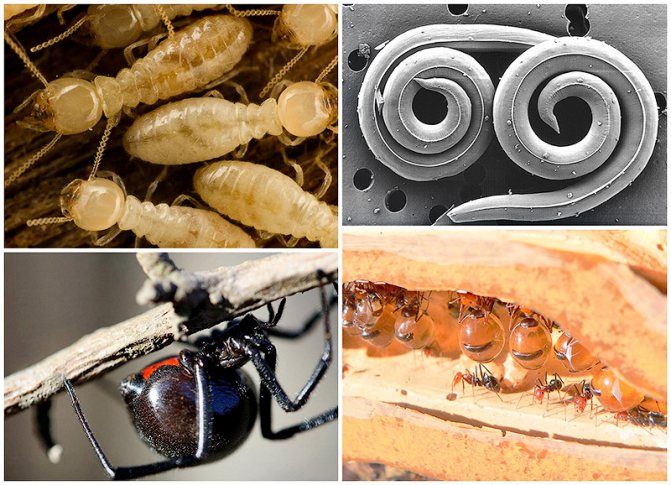

Insects are an integral part of the ecosystem of our planet. There are more than 5 million different types of insects on planet Earth, 1 million of them are dangerous. We have selected especially for you the 25 most dangerous insects, which you will read about later in the article ..
Termites
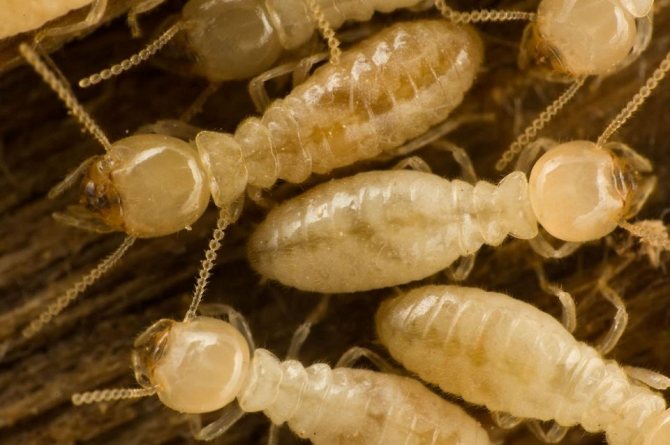

Termites do not pose a direct danger to humans, play an important role for the environment, moreover, in some cultures they are even eaten. But at the same time, baby termites can cause tremendous damage to infrastructure, sometimes making houses completely uninhabitable.
Lice
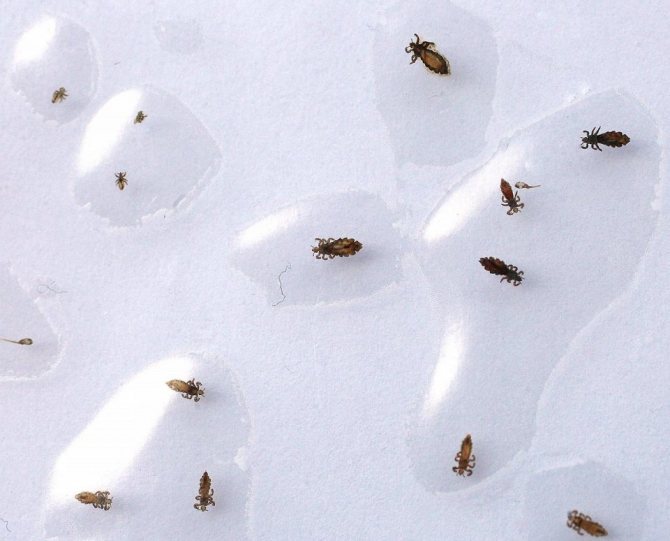

Lice are wingless parasites that feed on skin particles, blood and other secretions of the human body. Most often, humans are carriers of these insects, and there are approximately fifteen different types of lice in nature. Despite the fact that, like termites, lice do not always pose a direct threat to human health, they can be carriers of diseases.
Black-footed tick
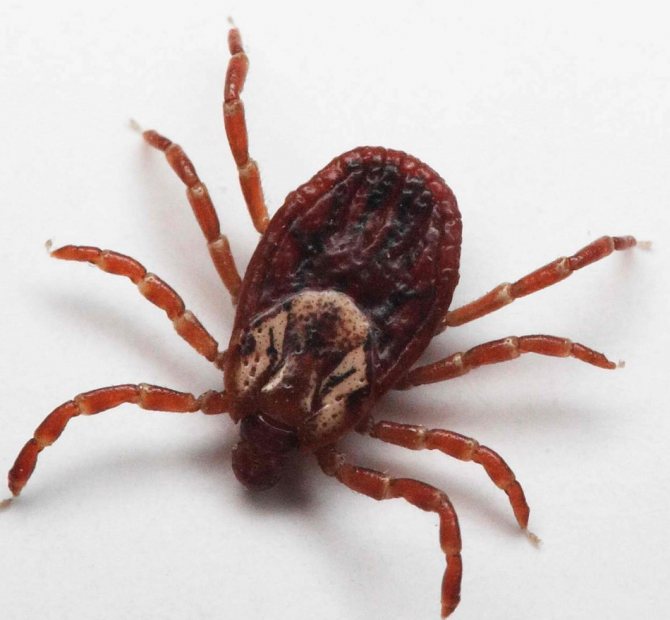

Each year, the black-footed tick infects thousands of people with Lyme disease, which begins with a rash around a bite that resembles a bull's eye. Early symptoms of this condition include headache and fever. With the further development of the disease, the victim also begins to suffer from problems with the cardiovascular system. Few die from these bites, but the effects can continue for years after an unpleasant encounter with a tick.
Nomadic ants
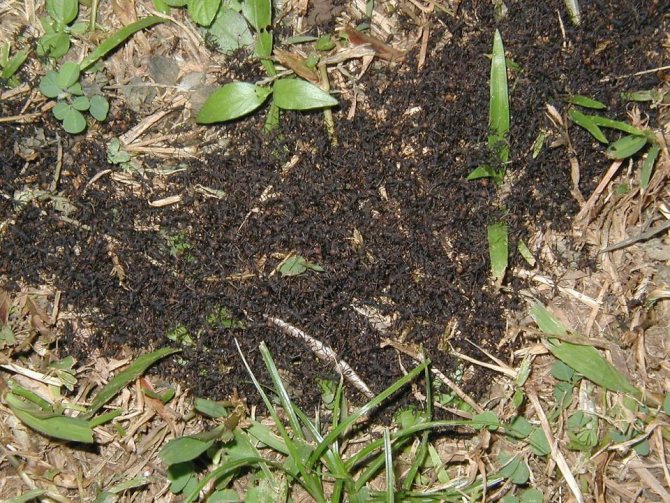

The first creature on our list that is literally dangerous are stray ants, known for their predatory aggression.Unlike other ant species, roaming ants do not build their own permanent nests. Instead, they create colonies that migrate from one place to another. These predators move constantly throughout the day, hunting insects and small vertebrates. In fact, the entire colony combined can kill more than half a million insects and small animals in one day.
Wasp
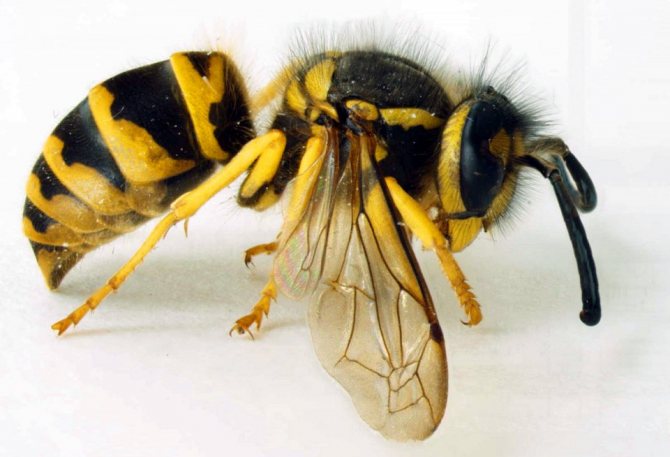

While most wasps are not particularly dangerous, certain species, such as the German wasp of North America, grow large and can be incredibly aggressive. If they sense danger or notice an invasion of their territory, they can sting repeatedly and very painfully. They will tag their aggressors and, in some cases, pursue them.
Black Widow
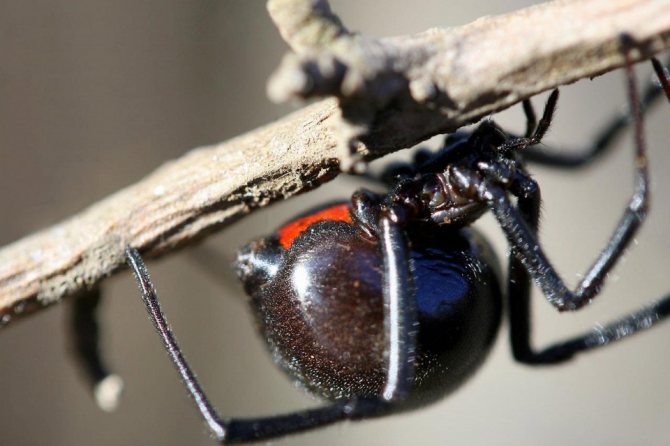

Despite the fact that the sting of the female Black Widow spider can be very dangerous to humans due to the neurotoxins released during the bite, if the necessary medical attention is provided in time, the consequences of the bite will be limited to only some pain. Unfortunately, isolated cases of death from the bite of the Black Widow did occur.
Hairy caterpillar Moli-coquette
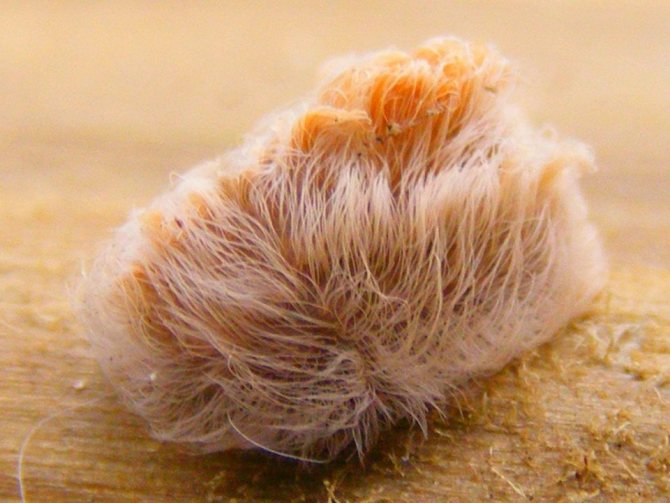

Although these Megalopyge opercularis coquette moth caterpillars look cute and fluffy, don't be fooled by their cartoonish appearance, they are extremely venomous.
Usually people believe that the hairs themselves are stinging, but in reality, the poison is released through the thorns hidden in this "wool". The thorns are extremely brittle and remain in the skin after being touched. The poison causes a burning sensation around the affected area, headache, dizziness, vomiting, sharp abdominal pains, damage to the lymph nodes and, sometimes, respiratory arrest.
Cockroaches
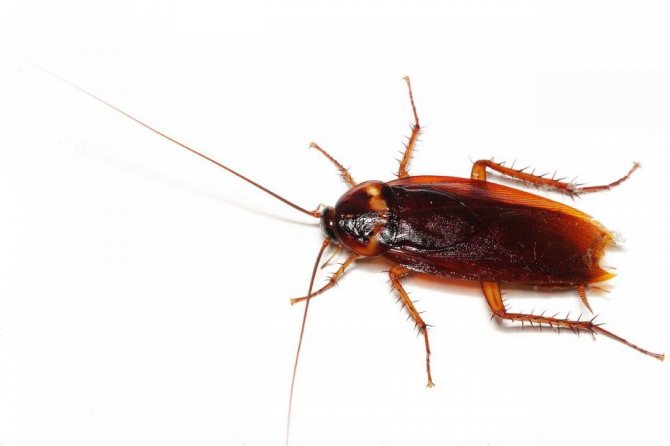

One of the most famous beetles, the cockroach is known as a carrier of many diseases that are dangerous to humans. The main danger of living together with cockroaches is that they climb into toilets, garbage cans and other places where bacteria accumulate, as a result, are their carriers. Cockroaches can cause many diseases, from worms and dysentery to tuberculosis and typhoid. Cockroaches can carry fungi, unicellular organisms, bacteria and viruses. And here's a fun fact - they can live for months without food or water.
Parasitic worms
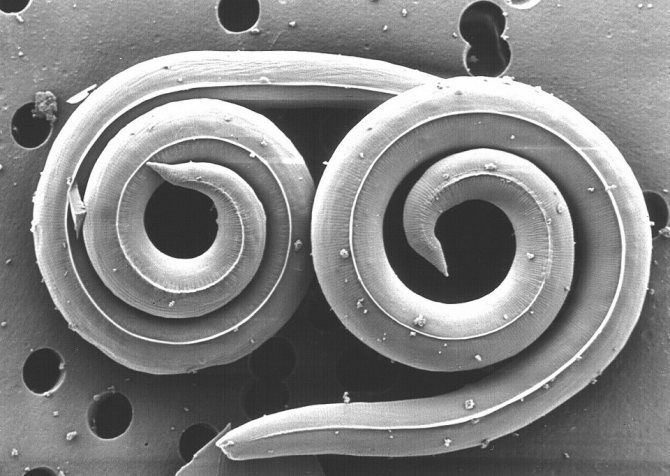

Parasitic worms are a type of eukaryotic parasite. Most parasitic worms are known to live in the human digestive tract and cause insomnia, vomiting, nausea, and numerous other health problems.
Bed bugs
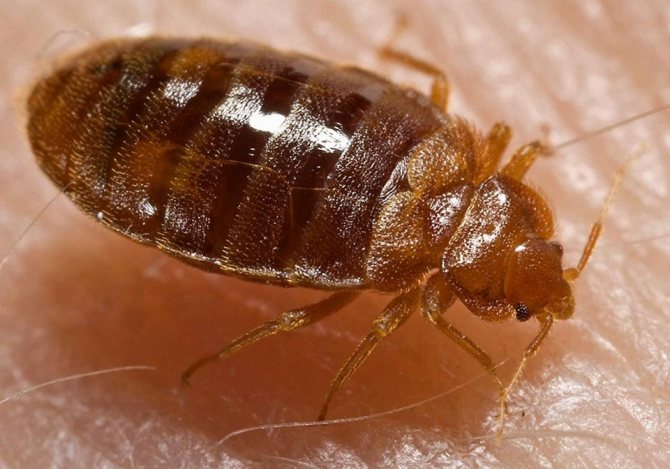

A person does not directly feel the bug bite itself, since an anesthetic substance is included in the saliva of the bug. If the bug from the first time could not get to the blood capillary, it can bite a person several times. At the site of the bug bite, severe itching begins, and a blister may also appear. Occasionally, people are faced with a severe allergic reaction to a bug bite. Fortunately, 70 percent of people experience virtually no repercussions from them.
Bedbugs are household insects and do not belong to the group of carriers of infectious diseases, however, in their body they can retain pathogens that transmit infections through the blood for a long time, these include: viral hepatitis B, pathogens of plague, tularemia, and Q-fever can also persist. They deliver the greatest harm to people with their bites, taking away normal rest and sleep from a person, which subsequently can negatively affect moral health and performance.
Human gadfly
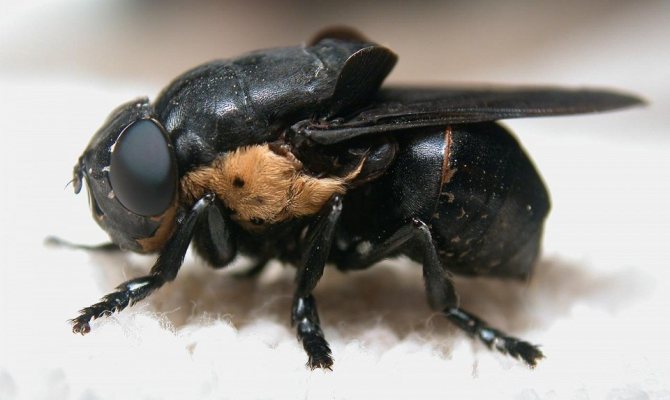

Human gadflies have larvae that can transmit life-threatening parasites to humans. Also known as torsalo, human gadflies are commonly transmitted by mosquitoes. When a mosquito carrying a human gadfly larva lands on the skin, the larva enters the host's body.After a few days, it grows under the skin and can cause serious infection if the mosquito bite is not treated right away.
Centipede
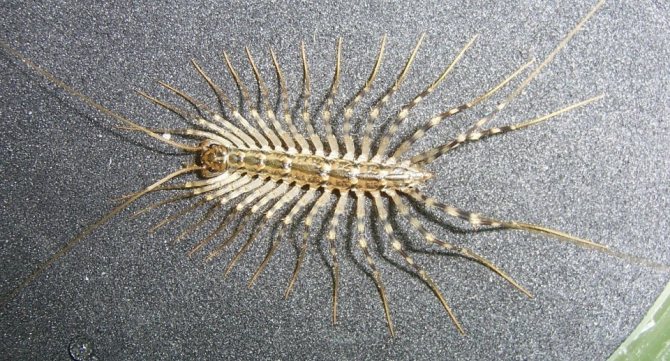

Centipede (Scutigera coleoptrata). This insect, also called the flycatcher, is believed to have originated in the Mediterranean. Although other sources speak of Mexico. The centipede has become very common throughout the world. Although unattractive in appearance, such insects generally do useful work, as they eat other pests and even spiders. True, with entomophobia (fear of insects), such an argument will not help. Usually people kill them because of their unpleasant appearance, although in some southern countries, centipedes are even protected. The flycatcher is a predator, they inject poison into the victim and then kill it. Flycatchers often live in apartments without harming food or furniture. They love moisture, often centipedes can be found in basements, under baths, in toilets. Flycatchers live from 3 to 7 years, newborns have only 4 pairs of legs, increasing them by one with each new molt. Usually, the bite of such an insect is not alarming for humans, although it can be comparable to a small bee sting. For some, it may even be painful, but usually the matter is limited to tears. Of course, centipedes are not insects that are responsible for thousands of deaths, but many of us will be surprised to learn that someone dies from these bites every year. The fact is that an allergic reaction to insect venom is possible, but this still happens extremely rarely.
Black scorpion
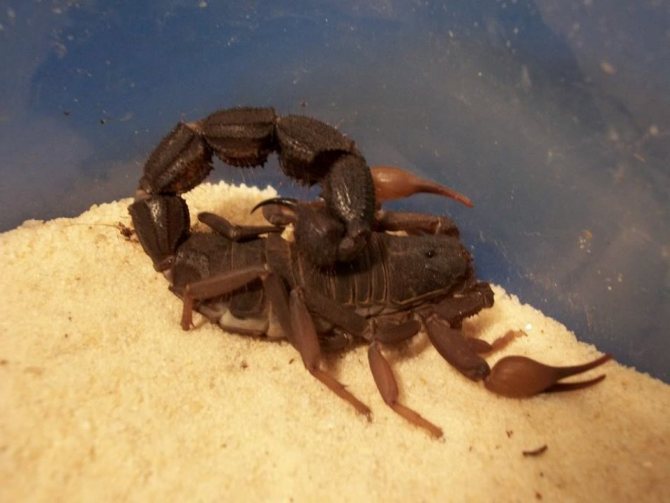

Despite the fact that scorpions do not belong to insects, since they belong to the order of arthropods from the class of arachnids, we still included them in this list, especially since black scorpions are among the most dangerous species of scorpions. Most of them live in South Africa, especially in desert areas. Black scorpions are distinguished from other species by their thick tails and slender legs. Black scorpions sting, injecting poison into their prey, which can cause pain, paralysis and even death of a person.
Predator
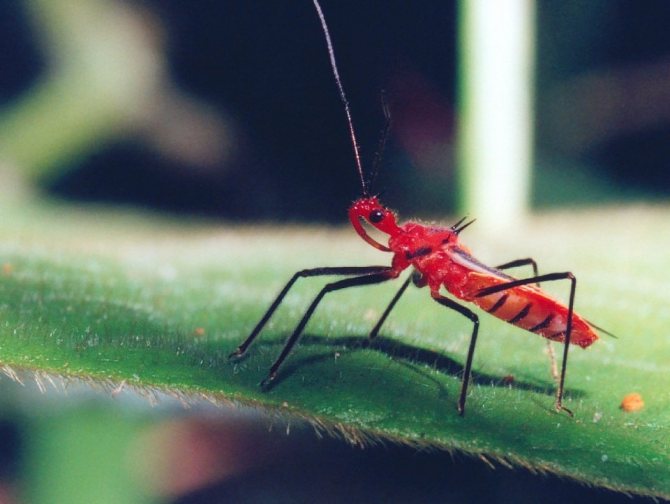

Another bloodsucker is the Predator, aka Assassin bug, aka Reduviidae. Their main diet is insects and their larvae, but some tropical species are not averse to drinking the blood of small animals and even humans. A predator responsible for the transmission of Chagas disease, this parasitic beetle often infects people living in poor rural areas.
Ant Bullet
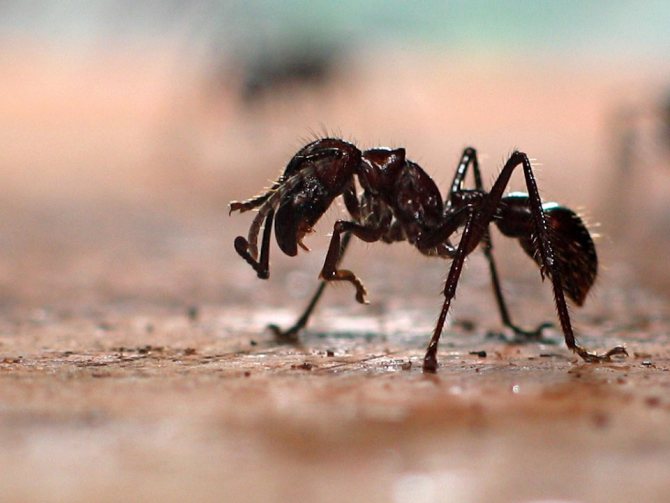

Paraponera clavata is a species of large tropical ants of the genus Paraponera Smith, and the subfamily Paraponerinae (Formicidae), which have a strong sting. Called an ant a bullet for the reason that bite victims compare it to being shot from a pistol.
A person bitten by such an ant can feel throbbing and relentless pain for 24 hours after the bite. In some local Indian tribes (Satere-Mawe, Maue, Brazil), these ants are used in very painful rites of initiation of boys into adulthood (which leads to temporary paralysis and even blackening of stung fingers). In the course of studying the chemical composition of the poison, a paralyzing neurotoxin (peptide) called poneratoxin was isolated from it.
Brazilian wandering spider
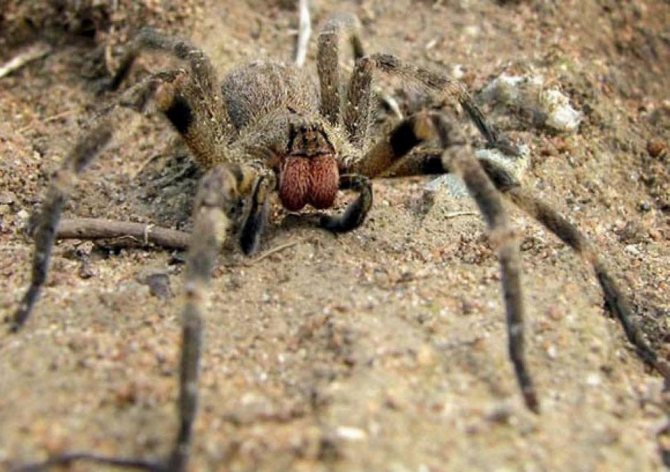

Also known as Phoneutria, Brazilian wandering spiders are venomous creatures that live in tropical South America and Central America. In the 2010 Guinness Book of World Records, this type of spider was named the most poisonous spider in the world.
The venom of this genus contains a powerful neurotoxin known as PhTx3. In lethal concentration, this neurotoxin causes loss of muscle control and breathing problems, leading to paralysis and eventually suffocation. The bite is of average pain, the poison causes an instant infection of the lymphatic system, getting into the circulatory system in 85% leads to heart failure. Patients feel rigor mortis during life, sometimes it causes priapism in men.There is an antidote that is equally used with antibiotics, but due to the severity of the poisonous harm to the body, the detoxification procedure is actually equal to the victim's chance of survival.
Malaria mosquito
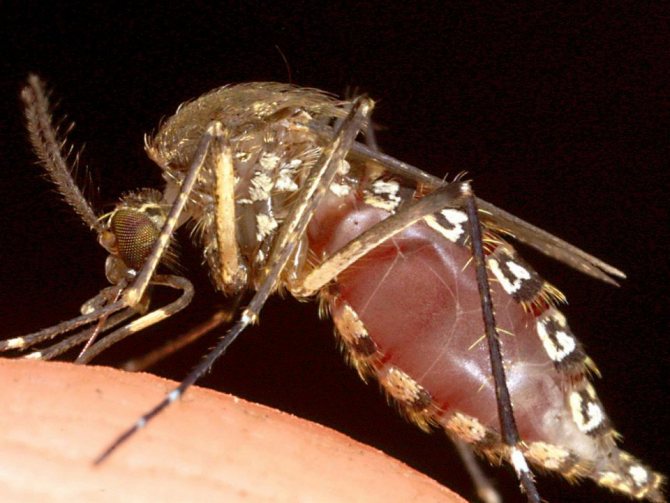

Malaria mosquitoes or anopheles are a genus of dipterans, many species of which are carriers of human parasites - malaria plasmodia. A mosquito becomes infected with Plasmodium malaria from a person - a sick person or a carrier. Plasmodium malaria goes through a cycle of sexual reproduction in the body of a mosquito. An infected mosquito becomes a source of infection for humans 4-10 days after infection and remains so for 16-45 days. Mosquitoes serve as carriers of other types of plasmodia, which cause malaria in animals.
Rat fleas
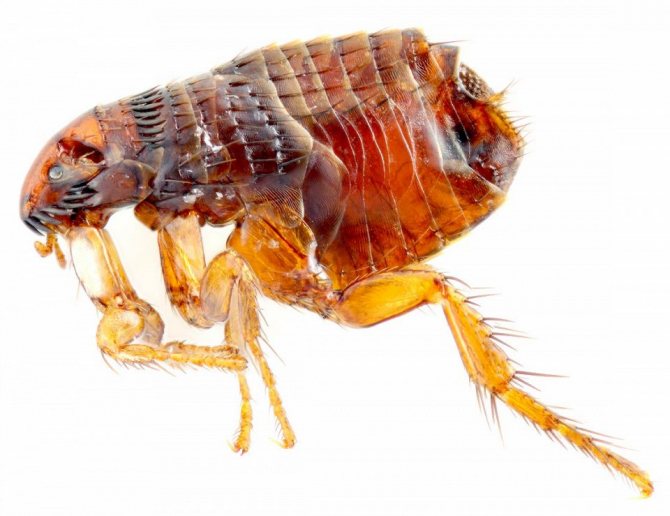

Rat fleas are one of the most dangerous flea species (Pulicidae) and carry the plague. They are parasites of rats (Rattus, Nesokia) and gerbils (Gerbillinae). They are carriers of the Plague bacillus (Yersinia pestis) and Rickettsia typhi, as well as intermediate hosts of the parasitic worms of the rat tapeworm Hymenolepis diminuta and the mouse tapeworm Hymenolepis nana. Diseases can be transmitted from one generation to the next through eggs.
African honey bee
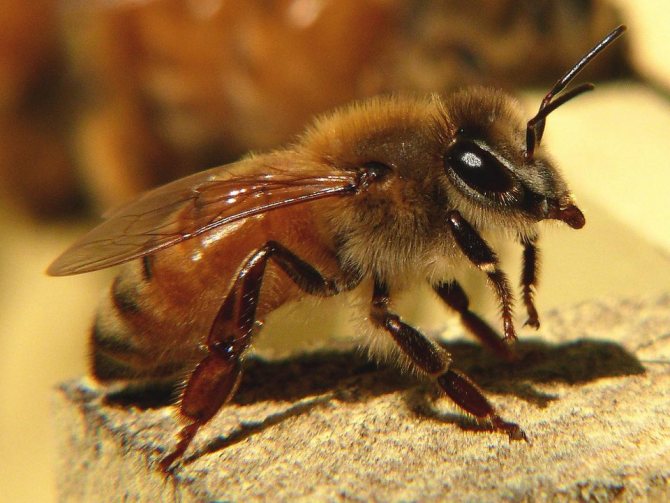

African bees (also known as "killer" bees) are descendants of bees brought from Africa to Brazil in the 1950s while trying to improve honey production in that country. Some African queens began to interbreed with native European bees. The resulting hybrids moved north and are still found in southern California today.
African bees look the same, and in most cases behave like the European bees that currently live in the United States. They can only be detected by DNA analysis. Their stings are also no different from a normal bee. One very important difference between the two species is the defensive behavior of African bees, which is shown when defending their nest. In some attacks in South America, African bees have killed livestock and people. This behavior earned the AMPs the nickname “Killer Bees”.
Moreover, this type of bee is known for behaving like an invader. Their swarms attack the hives of the common honey bee, invading them and establishing their queen. They attack in large colonies and are ready to destroy anyone who encroaches on their womb.
Fleas
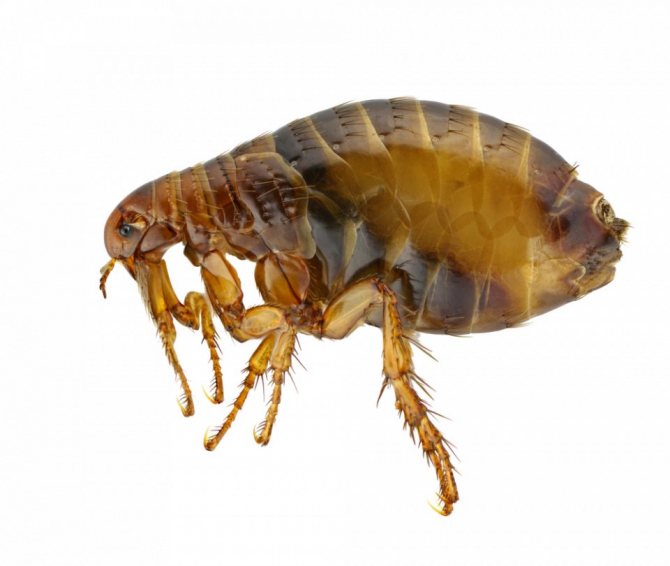

Although fleas are generally not perceived as dangerous, fleas transmit numerous diseases between animals and humans. Throughout history, they have contributed to the spread of many diseases such as the bubonic plague.
Fire ants


Fire ants are several related ants from the group of species Solenopsis saevissima species-group of the genus Solenopsis, which have a strong sting and poison, whose action is similar to a flame burn (hence their name). Most often, this name refers to the invasive Red Fire Ant, which has spread throughout the world. There are known cases of one ant stinging a person with serious consequences, anaphylactic shock, and even death.
Brown recluse spider
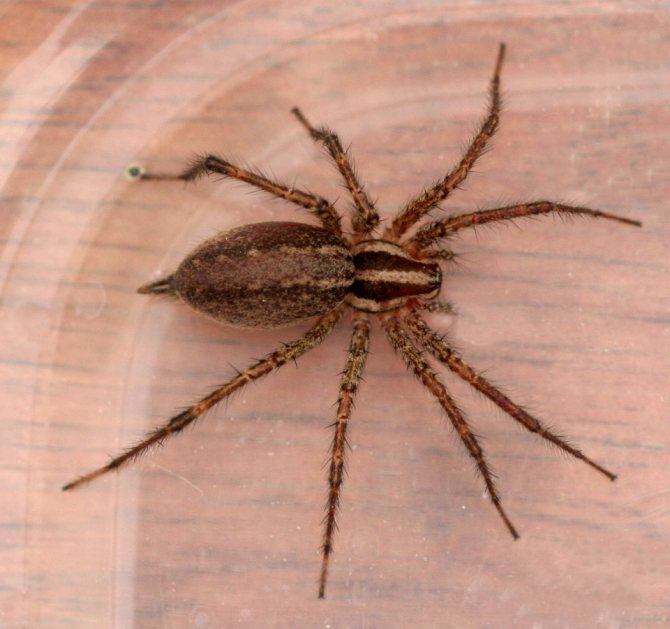

The second spider on our list, the Brown Hermit, does not release neurotoxins like the Black Widow. Its bite destroys tissue and can cause damage that can take months to heal.
The bite very often goes unnoticed, but in most cases the sensation is similar to that of a needle prick. Then within 2-8 hours the pain makes itself felt. Further, the situation develops depending on the amount of poison that has entered the bloodstream. The venom of the brown recluse spider has a hemolytic effect, which means it causes necrosis and tissue destruction. A bite for young children, elderly and sick people can be fatal.
Siafu ants
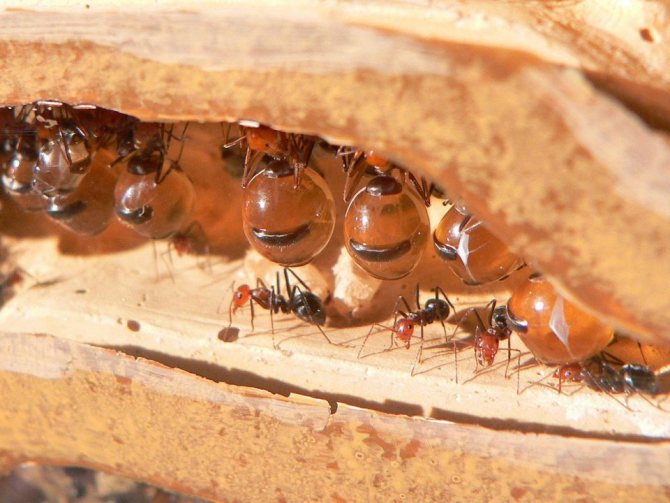

Siafu (Dorylus). These nomadic ants are mainly found in East and Central Africa, but have also been found in tropical Asia.Insects live in colonies that can number up to 20 million individuals, all of them blind. They make their travels with the help of pheromones. The colony does not have a permanent place of residence, wandering from place to place. In the course of movement to feed the larvae, insects attack all invertebrates. Among these ants there is a special group - soldiers. It is they who can sting, for which they use their hooked jaws, and the size of such individuals reaches 13 mm. The jaws of the soldiers are so strong that in some places in Africa they are even used to secure sutures. The wound can be closed for as long as 4 days. Usually, after a Siafu bite, the consequences are minimal, you don't even need to call a doctor. True, it is believed that young and old people are especially sensitive to the bites of such ants, there have been deaths from complications after contact. As a result, annually, according to statistics, from 20 to 50 people die from these insects. This is facilitated by their aggressiveness, especially when protecting their colony, which a person can accidentally attack.
Giant asian bumblebee
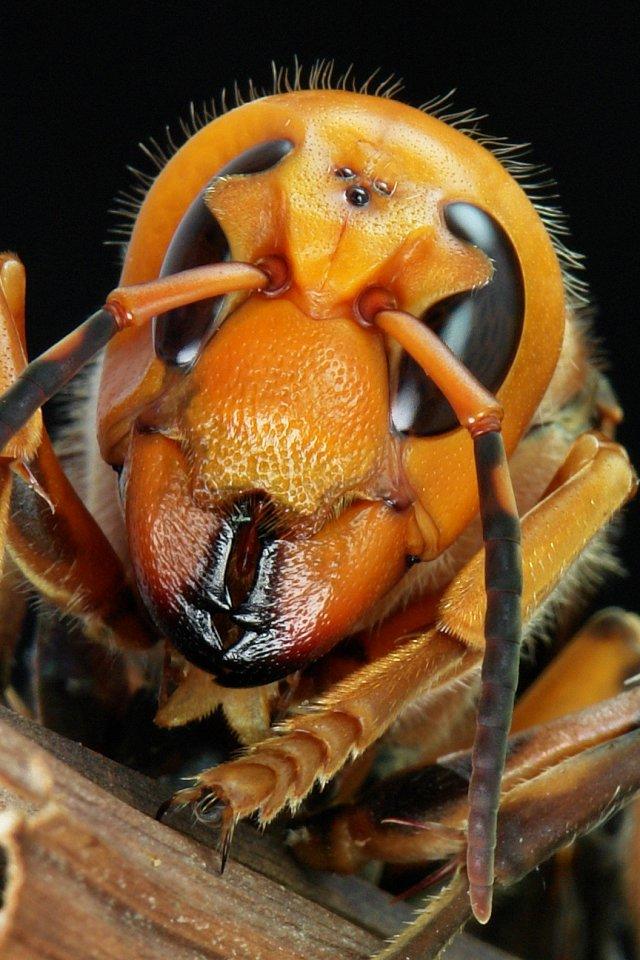

Many of us have seen bumblebees, they seem rather small, and there is little reason to be afraid of them. Now imagine a bumblebee growing up as if on steroids, or just look at an Asian giant. These hornets are the largest in the world - they can be up to 5 cm long and have a wingspan of 7.5 centimeters. The length of the sting in such insects can be up to 6 mm, but neither a bee nor a wasp can compare with such a bite, bumblebees, moreover, can sting many times. You cannot find such dangerous insects in Europe or the United States, but when traveling through East Asia and the mountains of Japan, you can meet them. To understand the consequences of a bite, it is enough to listen to eyewitnesses. They compare the sensation of a bumblebee sting to a hot nail driven into the leg. The sting venom has 8 different compounds that cause discomfort by damaging soft tissues and creating an odor that can attract new bumblebees to the victim. People who are allergic to bees can die from the reaction, but there have been deaths due to mandorotoxin poison, which can be dangerous if it gets deep enough into the body. It is believed that about 70 people die from such bites every year. Curiously, the sting is not their main hunting weapon - bumblebees crush their enemies with large jaws.
Tsetse fly


The tsetse fly lives in tropical and subtropical Africa, having chosen the Kalahari and Sahara deserts. Flies are carriers of trypanosomiasis, which cause sleeping sickness in animals and humans. Tsetse are anatomically very similar to their normal relatives - they can be distinguished by the proboscis on the front of the head and the special manner of folding the wings. It is the proboscis that allows you to get the main food - the blood of wild mammals in Africa. On this continent, there are 21 species of such flies, which in their length can reach from 9 to 14 mm. You should not consider flies so harmless for humans, because they really kill people, doing it quite often. It is believed that in Africa up to 500 thousand people are now infected with sleeping sickness, carried by this particular insect. The disease disrupts the activity of the endocrine and cardiac systems. The nervous system is then affected, causing confusion and sleep disturbance. Fatigue is followed by hyperactivity. The last major epidemic was recorded in Uganda in 2008, in general, the disease belongs to the list of forgotten in the WHO. However, in Uganda alone over the past 6 years, 200,000 people have died from sleeping sickness. The disease is believed to be largely responsible for the deteriorating economic situation in Africa. It is curious that flies attack any warm object, even a car, but they do not attack a zebra, considering it only by flickering stripes. The tsetse flies also saved Africa from soil erosion and overgrazing caused by cattle.Man came up with different methods of dealing with these insects. In the 1930s, all wild pigs were exterminated on the west coast, but this gave a result only for 20 years. Now they are fighting by shooting wild animals, cutting down bushes and treating male flies with radiation in order to deprive them of the opportunity to reproduce.
Summing up
- Summing up, we can say that the danger of ants is very great and it is better not to meet such killer insects. Regarding which species can be considered the most dangerous, it is a bullet ant. Although the poison of other representatives is no less dangerous, they occupy a leading position due to their lifestyle and behavior during the attack.
- Their difference lies in the fact that they are in the trees, and this is the last place to beware of due to the presence of ants. In addition, when attacking, they emit loud sounds, which means that the victim will be attacked by the entire colony, and not by a few little goosebumps.
- In Indian tribes, there is a rather cruel (from our point of view) rite, which is intended for boys to become adult youths. When a guy reaches the age of majority, a special cape is woven for him on his hands.
- It is woven from fresh leaves, into which ants are woven, not just a few or even dozens of them, but hundreds of insects with stinging outward. A young man must put a cape on his hands and stand in it for 10 minutes, during which time hundreds of insects inflict incredibly painful bites.
- This leads to paralysis of the limbs, and the young man himself suffers from convulsions for several days. He must pass this test not once, but about 20.
What are the features of the development of insects
All ants have 4 stages of development. The stages include:
- egg;
- larva;
- chrysalis;
- an adult.
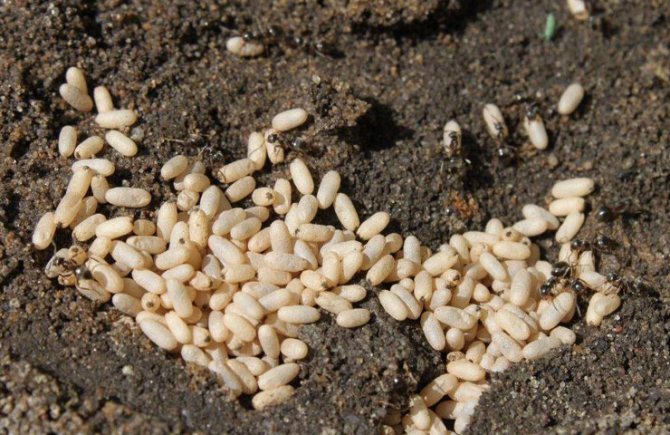

Ants lay eggs from which larvae hatch
The larvae are white. At the initial stage of development, they are completely immobile. After a while, the insect pupates and then becomes an adult ant.
The body length of ants is usually small and does not exceed a couple of centimeters, depending on the species.

